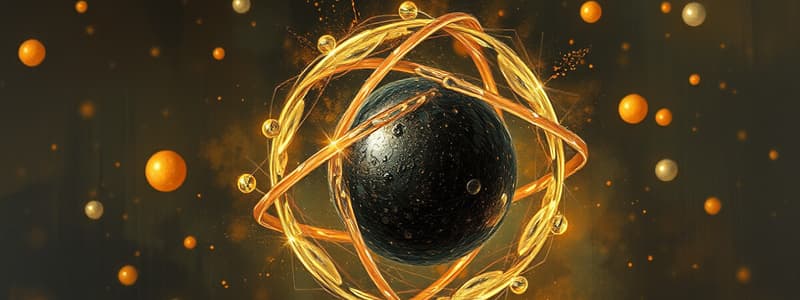Podcast
Questions and Answers
How many protons, neutrons, and electrons does a silicon, Si, atom have, and where are these two types of subatomic particles located?
How many protons, neutrons, and electrons does a silicon, Si, atom have, and where are these two types of subatomic particles located?
14 protons, 14 neutrons, 14 electrons; protons and neutrons are in the nucleus.
Explain why different atoms of the same element always have the same atomic number but can have different mass numbers. What are these different atoms called?
Explain why different atoms of the same element always have the same atomic number but can have different mass numbers. What are these different atoms called?
Different atoms of the same element have the same atomic number because they have the same number of protons; they are called isotopes.
What does an element's molar mass tell you about the element?
What does an element's molar mass tell you about the element?
It gives us an idea about its weight of nucleus.
What is an orbital?
What is an orbital?
Which of Dalton's statements about the atom was proven false by J.J. Thomson?
Which of Dalton's statements about the atom was proven false by J.J. Thomson?
What did Rutherford learn about the atom from his gold-foil experiment?
What did Rutherford learn about the atom from his gold-foil experiment?
If an atom has a mass of 11 u and contains five electrons, what must its atomic number be?
If an atom has a mass of 11 u and contains five electrons, what must its atomic number be?
Which statement is not true of Bohr's model of the atom?
Which statement is not true of Bohr's model of the atom?
According to the modern model of the atom, what do moving electrons form?
According to the modern model of the atom, what do moving electrons form?
Carbon has six protons. How many valence electrons does carbon have?
Carbon has six protons. How many valence electrons does carbon have?
The second energy level has 1 s orbital and 3 p orbitals. How many electrons can this energy level hold?
The second energy level has 1 s orbital and 3 p orbitals. How many electrons can this energy level hold?
An electron moves from the ground state to an excited state when it absorbs what?
An electron moves from the ground state to an excited state when it absorbs what?
Which of the deflections, A or B, in Rutherford's gold-foil experiment was a surprise, and why?
Which of the deflections, A or B, in Rutherford's gold-foil experiment was a surprise, and why?
Identify the particles that make up an atom. How do these particles relate to the identity of an atom?
Identify the particles that make up an atom. How do these particles relate to the identity of an atom?
Determine the atomic number and mass number of an isotope that has 56 electrons and 82 neutrons.
Determine the atomic number and mass number of an isotope that has 56 electrons and 82 neutrons.
Why do most atoms have no charge even though they are made up of positively charged protons and negatively charged electrons?
Why do most atoms have no charge even though they are made up of positively charged protons and negatively charged electrons?
Which diagrams represent the same element?
Which diagrams represent the same element?
What is the atomic number for atom A?
What is the atomic number for atom A?
What is the mass number for atom B?
What is the mass number for atom B?
Flashcards are hidden until you start studying
Study Notes
Atomic Structure
- Silicon (Si) has an atomic number of 14, with 14 protons, 14 neutrons, and 14 electrons, all located in the nucleus.
- Isotopes are atoms with the same number of protons but different numbers of neutrons, which leads to different mass numbers while maintaining the same atomic number.
- Atomic mass provides insight into the weight of an element's nucleus.
Electron Configuration
- An orbital represents the region in an electron cloud where the probability of finding an electron is highest.
- Carbon has six protons and four valence electrons, important for chemical bonding.
- The second energy level can hold up to 18 electrons, including 1 s orbital and 3 p orbitals.
- Electrons can transition to an excited state by absorbing a photon.
Historical Atom Models
- J.J. Thomson disproved the idea that atoms cannot be subdivided.
- Rutherford's gold-foil experiment revealed that atoms contain electrons and demonstrated that mass is concentrated in the nucleus rather than uniformly distributed.
Atomic Identification
- An atom’s identity, defined by its atomic number, is determined by the number of protons, which is equal to the number of electrons in a neutral atom.
- An isotope with 56 electrons and 82 neutrons has an atomic number of 56 and a mass number of 138 (atomic number = protons = electrons; mass number = protons + neutrons).
Electric Neutrality
- Most atoms are electrically neutral due to equal numbers of protons and electrons, balancing out their positive and negative charges.
Visual Representation
- Diagrams A and C represent the same element based on their respective atomic structures.
Studying That Suits You
Use AI to generate personalized quizzes and flashcards to suit your learning preferences.




